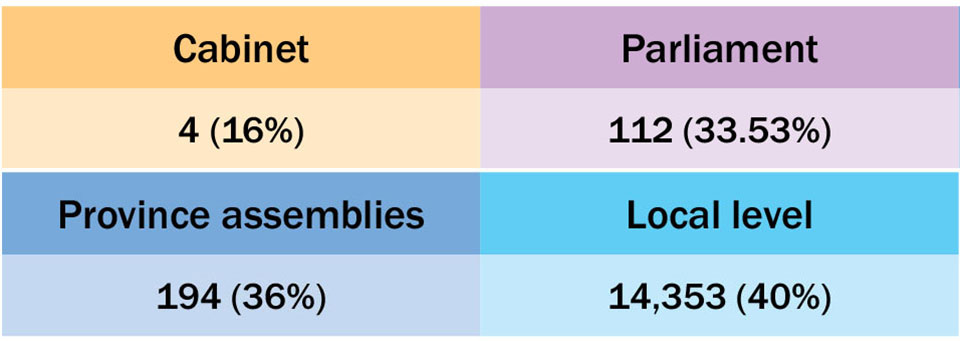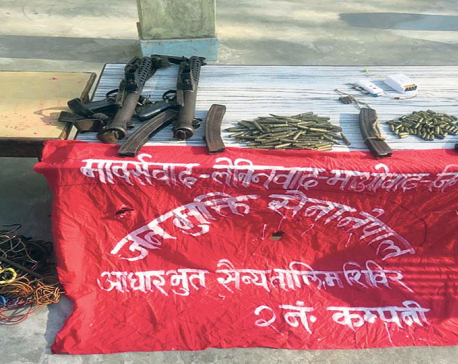
OR
More women in state structure under new constitution
Published On: March 8, 2019 09:00 AM NPT By: Bhasha Sharma

KATHMANDU, March 8: With the constitution promulgated in 2015 adopting women-friendly provisions, the representation of women has increased significantly throughout the state structure.
Various data show an increase in women’s representation in all state agencies following the elections for three tiers of governments under the federal structure in 2017 and the enactment of various laws to implement the new constitution.
Election of at least one-third women has been ensured in both houses of parliament and in the provincial assemblies, while nearly 40 percent of the elected representatives at local level are also women.
According to data provided by various government agencies, the inclusion of women has been increasing in the civil service and security agencies also. Although they are still under-represented in most state organs compared to their population, the status of women has been improving steadily in recent years. The presence of women in all state organs started to increase after the promulgation of the interim constitution in 2007 with its policy of inclusiveness.
And Article 38 of the 2015 constitution has enshrined the Rights of Women as fundamental rights. In addition to equal rights to property and ancestral property, the statute has ensured them the right to proportional representation in all state agencies.
Likewise, the constitution has proposed a policy of positive discrimination for women in education, health, employment and social security.
Top state positions
Irrespective of legal and constitutional provisions, the presence of women is not high in the top political leadership. However, their presence has been increasing at the policy-making levels.
There are only four women ministers in the 25-member Oli cabinet. The three ministers and one state minister add up to 16 percent of the cabinet strength. The country has re-elected Bidya Bhandari as head of state, while women have headed both the judiciary and the legislative branch under the new constitution. Sushila Karki became chief justice and Onsari Gharti speaker of the lower house.
Parliament
Altogether 112 out of the 334 members of parliament under the federal structure, which includes the House of Representatives and the National Assembly, are women. The 275-member lower house has 90 women while 22 women were elected to the 59-member upper house. This amounts to 33.53 percent overall, an all time high in the country.
Women constituted 33.3 percent of the 601-member first Constituent Assembly and 29.28 percent of the second one, which promulgated the new constitution.
Provincial Assemblies
At least 194 women have been elected to the total of 330 seats in the seven provincial assemblies. This amounts to 36 percent.
Local Level
Nearly 40 percent of those elected as people’s representatives at the local level are women. The constitution and election laws make it mandatory to elect a woman as either chief or deputy chief of the local bodies and reserve two ward committee memberships also for women.
According to the Election Commission, 14,353 women were elected to different posts at the 753 local units in the 2017 local level elections. Among these, 18 are mayors or chiefs of rural municipalities, 700 are deputy mayors or deputy chiefs, and 62 ward committee chiefs. Similarly, 6,742 women are ward committee members under women’s quota, 6,567 under Dalit women’s quota and 264 under open category.
Election of women at the local level ensures their presence in policy making bodies at that level. This presence could increase in the next local election.
Civil service
Out of 90,000 civil servants in the country 22,119 are women. Three of them have made it to the secretary level. According to government records, 38 women are at joint-secretary level and likely to reach secretary level before their retirement. The number of women in the civil service is increasing.
Security Agencies
Representation of women has been increasing in security agencies as well including in combat roles. However, it is still very low in the Nepal Army. There are only 4,518 women in the 90,000 strong army. Two women have made it to brigadier general and nine to colonel so far.
Similarly, there are at least 5,724 women in the 65,000 Nepal Police. According to police records, one additional inspector general, one deputy inspector general, four senior superintendents of police, eight superintendents of police and 24 DSPs are women.
You May Like This

Amazon confirms two employees in Italy have contracted coronavirus
WASHINGTON, March 2: Amazon.com Inc said late on Sunday that two employees in Milan, Italy, have contracted the coronavirus and... Read More...

Mysterious disease killing dogs in Norway
HELSINKI, Sept 8: Norwegian authorities haven’t been able to detect the cause behind an unexplained disease that is estimated to... Read More...

Govt restricts Chand group’s activities
KATHMANDU, March 13: The government on Tuesday outlawed the ‘political activities’ of the semi-underground Communist Party of Nepal led by... Read More...







Just In
- Govt appoints 77 Liaison Officers for mountain climbing management for spring season
- EC decides to permit public vehicles to operate freely on day of by-election
- Fugitive arrested after 26 years
- Indian Potash Ltd secures contract to bring 30,000 tons of urea within 107 days
- CAN adds four players to squad for T20 series against West Indies 'A'
- ‘Precast' technology introduced in the construction of bridges along Muglin-Pokhara road
- Leopard attack injures young man in Kanchanpur
- SC rejects writ petition filed against Home Minister Lamichhane












Leave A Comment